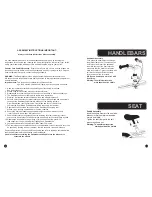
7
5.
With the heel of your hand, rotate the quick release lever in toward the bicycle.
Make sure the lever is tucked
against the frame or fork so that it is safe from trail hazards which might force it open.
As you rotate the
lever in toward the bike, you will feel resistance.
Do not tighten the quick release by holding the adjusting nut
and simply spinning the quick release lever. The cam action of the lever is necessary to ensure adequate
wheel attachment.
6.
If you did not feel resistance when tightening the lever, the quick release is not tight enough. Return the lever to the
open position (90½ from the bicycle), spin the adjuster nut clockwise a couple more turns, and retighten the lever,
testing for resistance.
7.
Repeat step 6 until you must use considerable, but not uncomfortable force to tighten the quick release lever.
8.
Make sure the quick release lever does not come in contact with the fork leg of the bicycle.
Once again, make sure
the quick release is tucked in so as not to be vulnerable to trail obstacles which might inadvertently
release it. Refer to Safety and Fit: Mechanical Quick Check to make sure you've tightened the quick re-
leases properly.
Wheel Removal
CAUTION: Improperly adjusted wheel quick releases can be extremely dangerous, and can result in failure
during use and severe injuries.
The wheels on your new K2 Bike are attached with convenient single lever quick releases, allowing them easily to be removed and reinstalled.
To remove a wheel, first disconnect the ”lead pipe“ from its holder and open up the brakes. Then open the quick release lever. You may need to
hold the adjusting nut opposite the quick release and spin the release lever before pulling the wheel free.
In the rear, shift the gears to the smallest cog and open the brakes by releasing the ”lead pipe“ on the V-Brakes. Open the quick release and, while
holding the bike off of the ground, firmly strike the top of the rear wheel. The wheel should fall off easily.
To reinstall the wheel, place the axle in the dropouts and gently push down on the bicycle to make sure the axle is firmly seated. The wheel should
be centered between the fork legs or the rear chainstays and seatstays. In the rear, line the smallest cog on the rear wheel with the chain and hold
the rear derailleur back while you slide the axle into the dropouts. Release the rear derailleur when the wheel is seated firmly in the frame. Follow
the instructions above on
Quick Releases
.
Braking
Your bicycle is equipped with a brake lever for each hand. The right lever operates the rear brake, while the left lever operates the front brake. You
should familiarize yourself with braking action through practice and repeated use. While both brakes is very effective in making quick stops, it’s
possible to initiate a loss of control by braking aggressively while turning on slippery surfaces. Also, recognize that water on your wheels will cause
the brakes to lose stopping power. Think ahead in wet situations and apply brakes earlier.
Many K2 Bike models are equipped with V-Brake - style brakes. These brakes provide a tremendous amount of stopping power and should be used
carefully. Make sure that you are familiar with the power of the brakes before you attempt any off-road riding.
Caution: Improper brake operation can be extremely dangerous and can result in severe injuries.
Shifting
There are two shifter controls mounted on your handlebars. It’s important that you learn to use the shifters to cycle effectively in varied terrain. The
left hand shifter controls the chain position on the front sprockets. The right hand shifter moves the chain from one sprocket to the next in the rear.
You should experiment with these controls until you become familiar with their use.
The pedals must be turning while you move the shifters. You should only put light pressure on the pedals during each shift so that the chain can
easily move from sprocket to sprocket. Optimal pedal rotation speed is 50 to 90 revolutions per minute.
You will find that shifting to a smaller front sprocket or a larger rear sprocket will allow you to climb hills easier. Move the chain closer to the center
of the bicycle to climb hills, and away from the center as speeds increase.
Open
Closed
Quick Release
Operation
Quick Release
Operation
V-Brake -style Brake
Release
Brake Lever
Proper Shifting
Climb Hills
High Speed
(Chain Movement)
!
!


































